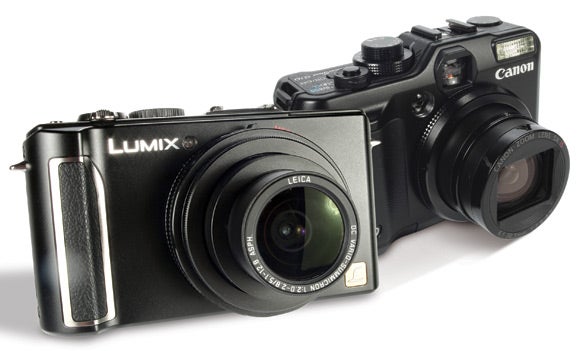Panasonic Lumix LX3 vs Canon PowerShot G10 – Performance & Value
Panasonic Lumix LX3 vs Canon PowerShot G10 – Performance & Value
One thing that thee Panasonic LX3 and Canon G10 share is that they are both excellent performers. They are an absolute pleasure to use, and with the additional, albeit relatively minimal,
manual controls offer something different to the standard compact camera market.
However, if you’re looking for a camera with a lightning-fast frame rate, then neither the G10 nor LX3 is likely to be the option for you – Canon’s G10 offers capture at a fairly slow 1.3fps at full resolution, while the LX3 offers a differing range of frame rates at varying resolution, the fastest being 6fps which, although quick, only utilises 3MP of the camera’s sensor.
While speed may not be overwhelming with regards to continuous shooting, the rest of the pair’s functionality displays an impressive swiftness. Both models offer a prompt start-up time, and in general use are intuitive enough to offer no obstacles to quick navigate. Auto focus is also impressive for both, though the Lumix LX3 is a touch quicker in most circumstances.
Both the LX3 and the G10 display small quirks with their metering. For example, Canon’s G10 has the slight tendency to overexpose, and as such highlights can appear a touch washed out. The LX3, on the other hand, has a slight propensity to underexpose, but as such highlights are better maintained and images offer an overall better tone.
It’s also worth noting that both cameras offer both Raw and JPEG capture. Now, this is somewhat of a bugbear for many in looking to get a creative compact camera. Most manufacturers have realised that the kind of photographer purchasing a creative camera is going to want full manual control over shutter speed and aperture, as they’re also realising that Raw capture is a welcome addition. After all, if you’re buying either the G10 or the LX3 to accompany your DSLR, chances are that you’re going to want the same kind of capture options your DSLR presents. As such, it’s welcome that both the G10 and the LX3 offer Raw capture.
One final point of note with the pair is fringing. While the Leica glass on the LX3 performs excellently in displaying little or no noticeable noise, the same cannot be said of the G10. Fringing is noticeable in any area of contrast or bold light, and although it’s by no means the worse display of the image quality flaw ever seen, it’s much more pronounced than the LX3.
Panasonic Lumix LX3 vs Canon PowerShot G10 – Value
Considering the range of similarities between both the G10 and LX3, analysing their respective values throws up some interesting results. The RRPs vary significantly – the Panasonic LX3 hit the market with a price tag of £399, while, with the recent rise in Canon prices, the RRP for the Canon G10 sits at £569. However, as is always the case with a camera being on the market for any substantial period of time, the pair sport street prices of £340 and £380 respectively – a fair amount less than the suggest retail prices…
Owing to the relative similarity of the pair, the £40 price difference is understandable, and while that places both cameras at a price point approaching and entry-level DSLR, the combination of advanced functionality in a compact package mean that both the G10 and LX3 are still a good value proposition.





